Cyclic Behavior of Anchored Blind-Bolted Extended End-Plate Joints to CFST Columns
Abstract
1. Introduction
2. Materials and Methods
2.1. Specimen Design
2.2. Testing of Material Properties
2.3. Test Setup
2.4. Displacement Measurement
3. Results
Test Observation and Failure Modes
4. Discussion
4.1. Moment-Rotation Hysteresis Curves
4.2. Moment-Rotation Envelope Curves
4.2.1. Effect of the Steel Tube Wall Thickness on Joint Performance
4.2.2. Effect of the End-Plate Thickness on Joint Performance
4.2.3. Effect of the Local Strengthening Connection Method and Anchorage Method on Joint Performance
4.2.4. Effect of the Steel Beam Section on Joint Performance
4.2.5. Effect of the Stiffeners on Joint Performance
4.3. Classification of the Tested Joints
4.4. Rotational Capacity and Ductility Ratio
4.5. Strength Degradation
4.6. Stiffness Degradation
4.7. Energy Dissipation
5. Finite Element Analysis
5.1. Finite Element Modeling
5.2. Finite Element Analysis and Test Result Comparison
5.2.1. Moment-Rotation Relationship
5.2.2. Failure Mode
5.3. Force Transfer Pattern
6. Conclusions
Author Contributions
Funding
Conflicts of Interest
References
- Han, L.; Li, W.; Bjorhovde, R. Developments and advanced applications of concrete-filled steel tubular (CFST) structures: Members. J. Constr. Steel Res. 2014, 100, 211–228. [Google Scholar] [CrossRef]
- Varma, A.H.; Ricles, J.M.; Sause, R.; Lu, L.W. Seismic behavior and modeling of high-strength composite concrete-filled steel tube (CFT) beam-columns. J. Constr. Steel Res. 2002, 58, 725–758. [Google Scholar] [CrossRef]
- Lai, Z.; Varma, A.; Zhang, K. Noncompact and slender rectangular CFT members: Experimental database, analysis, and design. J. Constr. Steel Res. 2014, 101, 455–468. [Google Scholar] [CrossRef]
- Zhao, Y.; Xu, C. Research on Compression Behavior of Square Thin-Walled CFST Columns with Steel-Bar Stiffeners. Appl. Sci. 2018, 8, 1602. [Google Scholar]
- Wang, Z.; Tao, Z.; Li, D.; Han, L. Cyclic behaviour of novel blind bolted joints with different stiffening elements. Thin-Walled Struct. 2016, 101, 157–168. [Google Scholar] [CrossRef]
- Wang, J.; Han, L.; Uy, B. Behaviour of flush end plate joints to concrete-filled steel tubular columns. J. Constr. Steel Res. 2009, 65, 925–939. [Google Scholar] [CrossRef]
- Lee, J.; Goldsworthy, H.M.; Gad, E.F. Blind bolted moment connection to sides of hollow section columns. J. Constr. Steel Res. 2011, 67, 1900–1911. [Google Scholar] [CrossRef]
- Lee, J.; Goldsworthy, H.M.; Gad, E.F. Blind bolted moment connection to unfilled hollow section columns using extended T-stub with back face support. Eng. Struct. 2011, 33, 1710–1722. [Google Scholar] [CrossRef]
- Málaga-Chuquitaype, C.; Elghazouli, A.Y. Behaviour of combined channel/angle connections to tubular columns under monotonic and cyclic loading. Eng. Struct. 2010, 32, 1600–1616. [Google Scholar] [CrossRef]
- Gardner, A.; Goldsworthy, H. Moment-resisting connections for composite frames. In Mechanics of Structures and Materials Conference; CRC Press: Boca Raton, FL, USA, 1999; pp. 309–314. [Google Scholar]
- Gardner, A.P.; Goldsworthy, H.M. Experimental investigation of the stiffness of critical components in a moment-resisting composite connection. J. Constr. Steel Res. 2005, 61, 709–726. [Google Scholar] [CrossRef]
- Goldsworthy, H.M.; Gardner, A.P. Feasibility study for blind-bolted connections to concrete-filled circular steel tubular columns. Struct. Eng. Mech. 2006, 24, 463–478. [Google Scholar] [CrossRef]
- Goldsworthy, H.; Yao, H.; Gad, E. Experimental and Numerical Investigation of the Tensile Behavior of Blind-Bolted T-Stub Connections to Concrete-Filled Circular Columns. J. Struct. Eng. 2008, 134, 198–208. [Google Scholar]
- Wang, J.; Chen, X.; Shen, J. Performance of CFTST column to steel beam joints with blind bolts under cyclic loading. Thin-Walled Struct. 2012, 60, 69–84. [Google Scholar] [CrossRef]
- Wang, J.; Guo, S. Structural performance of blind bolted end plate joints to concrete-filled thin-walled steel tubular columns. Thin-Walled Struct. 2012, 60, 54–68. [Google Scholar] [CrossRef]
- Tizani, W.; Ridley, E. The Performance of a New Blind-Bolt for Moment-Resisting Connections; Taylor & Francis: Abingdon, UK, 2003. [Google Scholar]
- Pitrakkos, T.; Tizani, W. Experimental behaviour of a novel anchored blind-bolt in tension. Eng. Struct. 2013, 49, 905–919. [Google Scholar] [CrossRef]
- Agheshlui, H.; Goldsworthy, H.; Gad, E.; Fernando, S. Tensile behaviour of anchored blind bolts in concrete filled square hollow sections. Mater. Struct. 2016, 49, 1511–1525. [Google Scholar] [CrossRef]
- Agheshlui, H.; Goldsworthy, H.; Gad, E.; Yao, H. Tensile Behavior of Groups of Anchored Blind Bolts within Concrete-Filled Steel Square Hollow Sections. J. Struct. Eng. 2016, 142, 04015125. [Google Scholar] [CrossRef]
- Tizani, W.; Al-Mughairi, A.; Owen, J.S.; Pitrakkos, T. Rotational stiffness of a blind-bolted connection to concrete-filled tubes using modified Hollo-bolt. J. Constr. Steel Res. 2013, 80, 317–331. [Google Scholar] [CrossRef]
- Tizani, W.; Wang, Z.Y.; Hajirasouliha, I. Hysteretic performance of a new blind bolted connection to concrete filled columns under cyclic loading: An experimental investigation. Eng. Struct. 2013, 46, 535–546. [Google Scholar] [CrossRef]
- Technical Specification for Concrete Structures of Building; JGJ3-2010; China Architecture and Building Press: Beijing, China, 2011.
- Peter Clark, K.F.H.K. Protocol for Fabrication, Inspection, Testing, and Documentation of Beam-Column Connection Tests and Other Experimental Specimens; Rep. No. SAC/BD-97/02; SAC Joint Venture: Sacramento, CA, USA, 1997. [Google Scholar]
- He, Y.; Huang, P.; Guo, J.; Zhou, H.; Li, Y. Experimental study on seismic behavior of steel-reinforced concrete square column and steel beam joint with bolted end-plate. J. Build. Struct. 2012, 33, 116–125. [Google Scholar]
- Tao, Z.; Hassan, K.; Song, T.-Y.; Han, L.-H. Experimental study on blind bolted connections to concrete-filled stainless steel columns. J. Constr. Steel Res. 2017, 128, 825–838. [Google Scholar] [CrossRef]
- Eurocode 3: Design of Steel Structures-Part 1–8. In Design of Joints; EN 1993–1-8; European Committee for Standardization: Brussels, Belgium, 2005.
- Eurocode 8: Design of Structures for Earthquake Resistance-Part 1: General Rules, Seismic Actions; BS EN 1998-1:2004; British Standard Institute: London, UK, 2011.
- Recommended Seismic Design Criteria for New Steel Moment-Frame Buildings; FEMA-350; Federal Emergency Management Agency: Washington, DC, USA, 2000.
- Wang, J.; Zhang, L.; Spencer, B.F. Seismic response of extended end plate joints to concrete-filled steel tubular columns. Eng. Struct. 2013, 49, 876–892. [Google Scholar] [CrossRef]
- Seismic Provisions for Structural Steel Buildings; ANSI/AISC 341-10; American Institute of Steel Construction: Chicago, IL, USA, 2010.
- Bahaari, M.R.; Sherbourne, A.N. Behavior of eight-bolt large capacity endplate connections. Comput. Struct. 2000, 77, 315–325. [Google Scholar] [CrossRef]
- Han, L.H.; Yao, G.H.; Zhao, X.L. Tests and calculations for hollow structural steel (HSS) stub columns filled with self-consolidating concrete (SCC). J. Constr. Steel Res. 2005, 61, 1241–1269. [Google Scholar] [CrossRef]

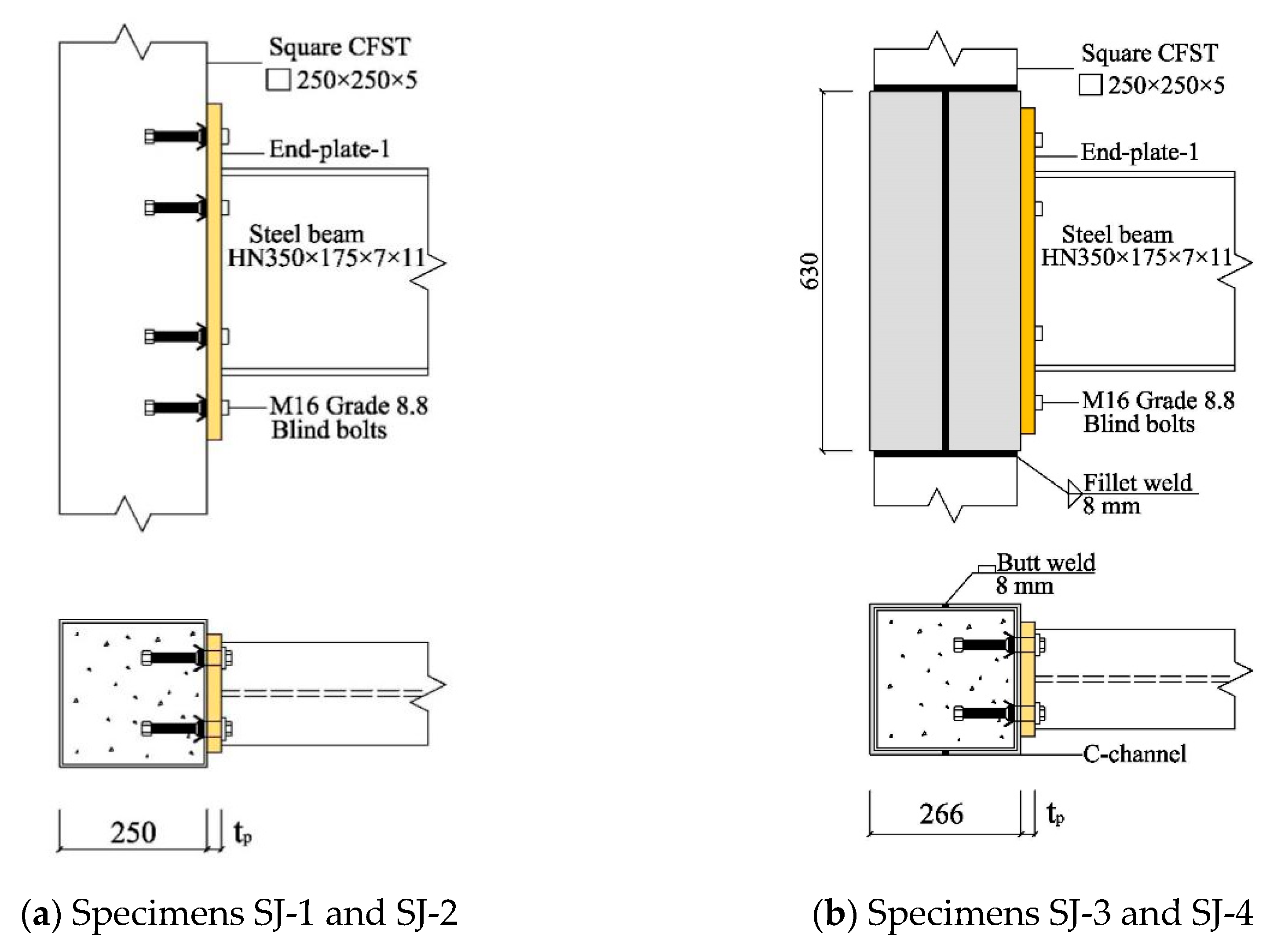


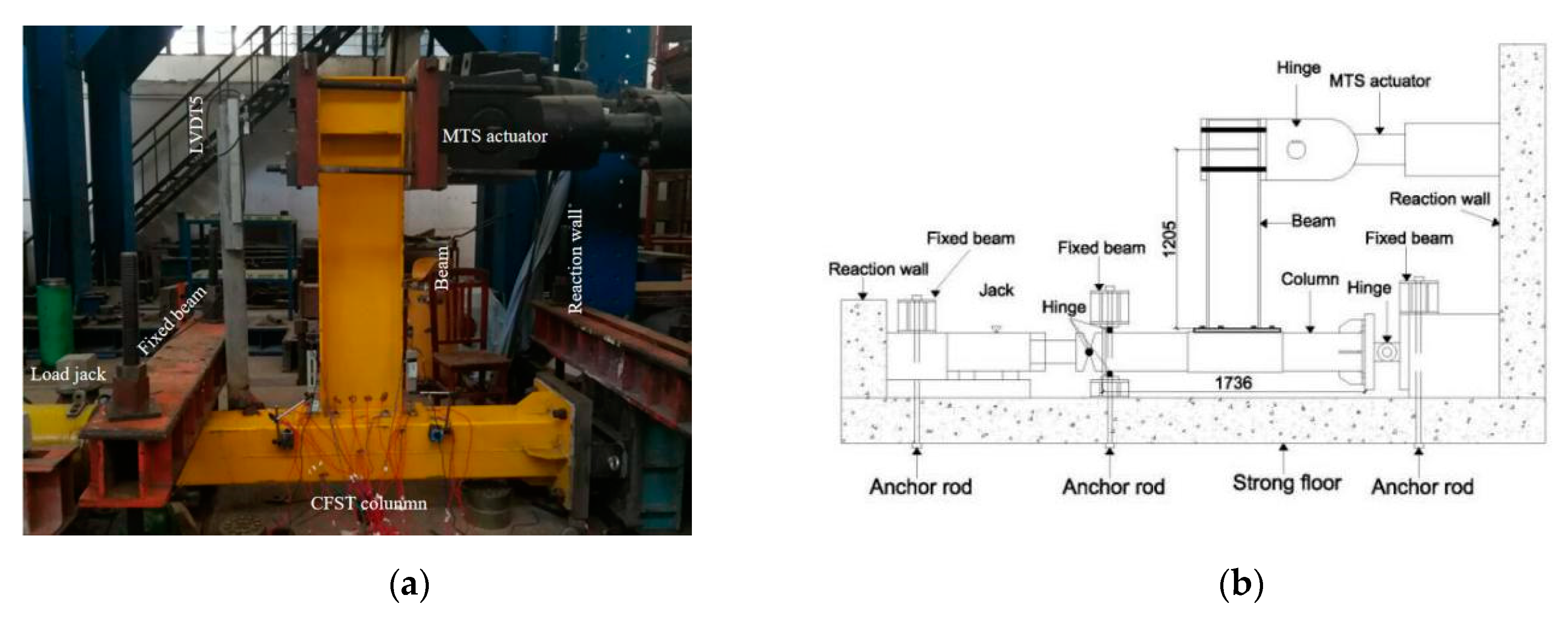
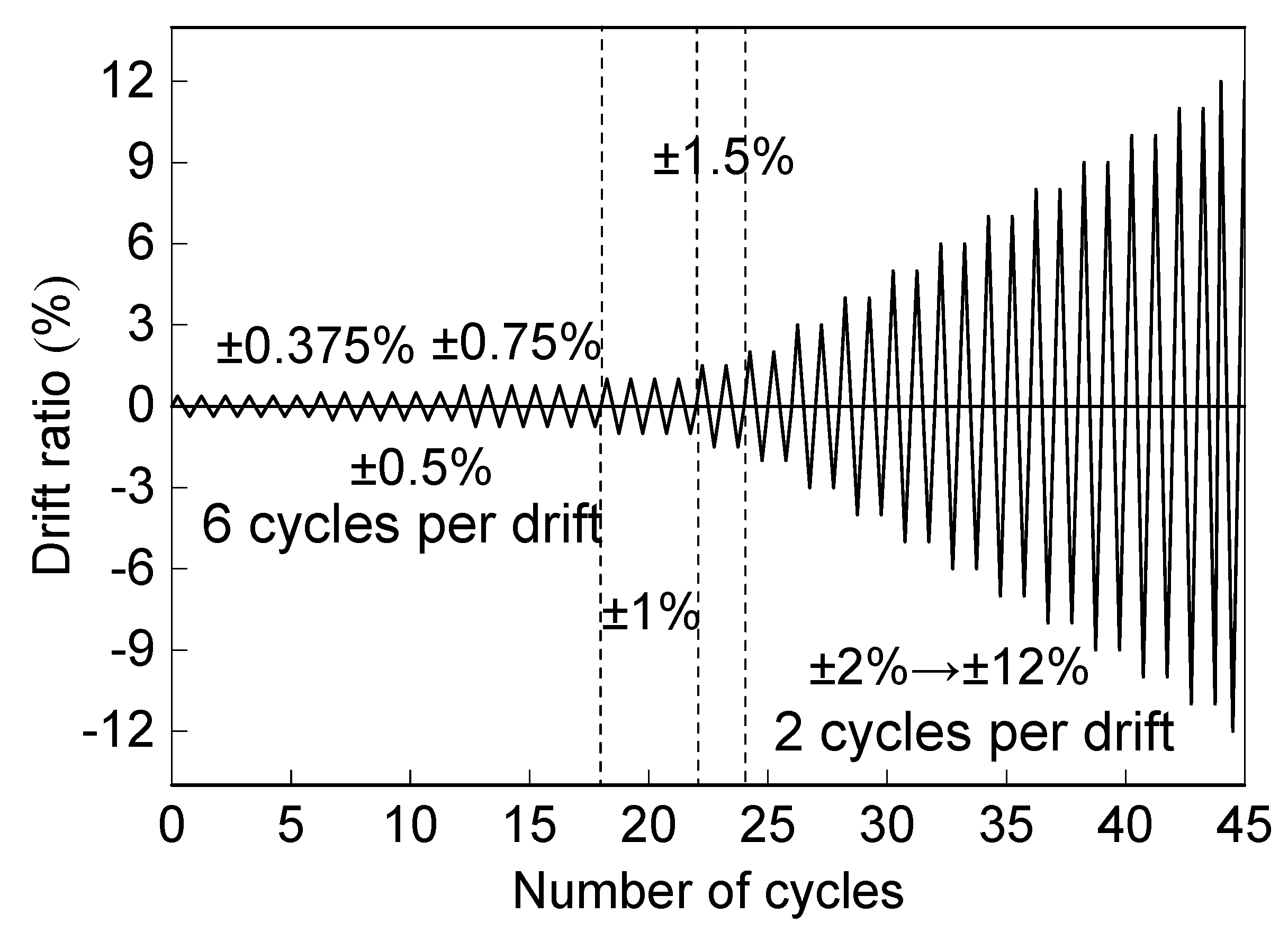
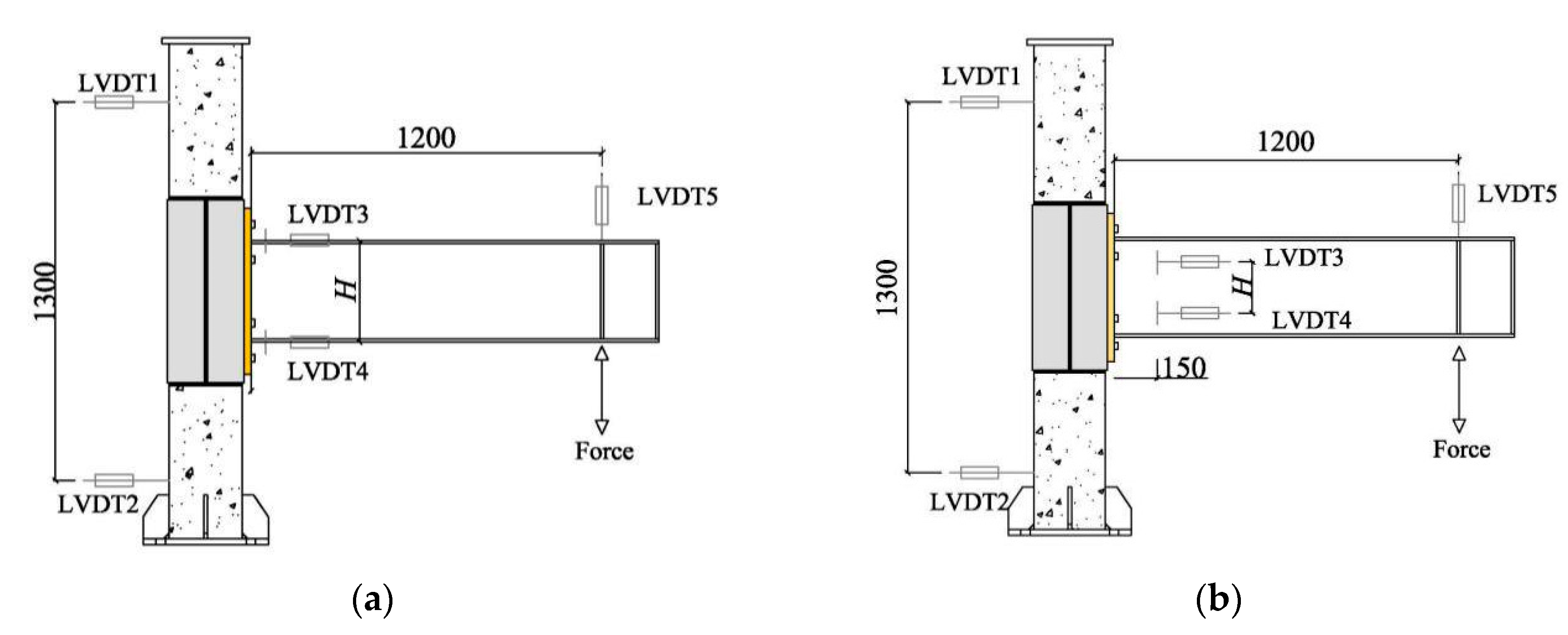
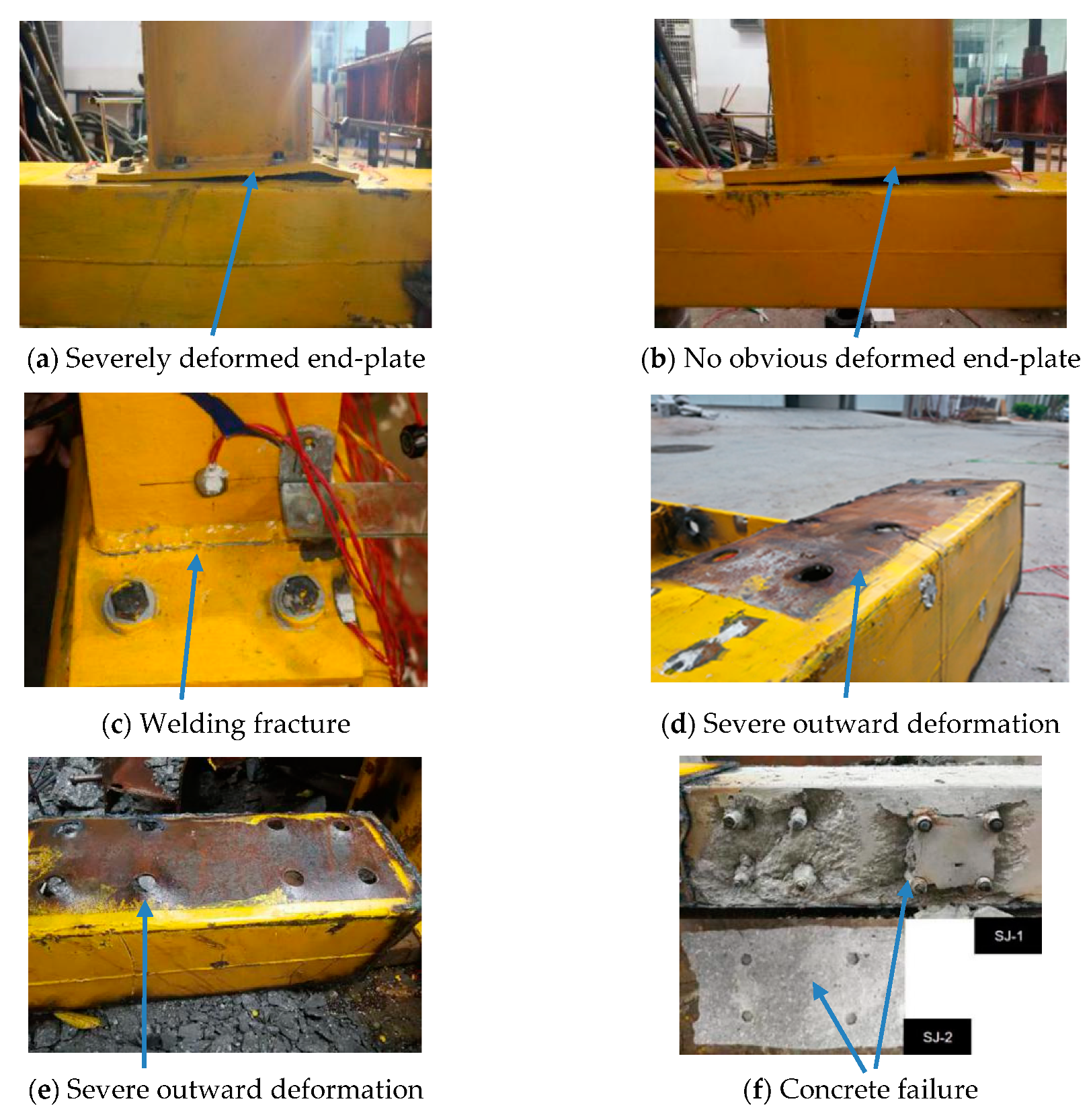
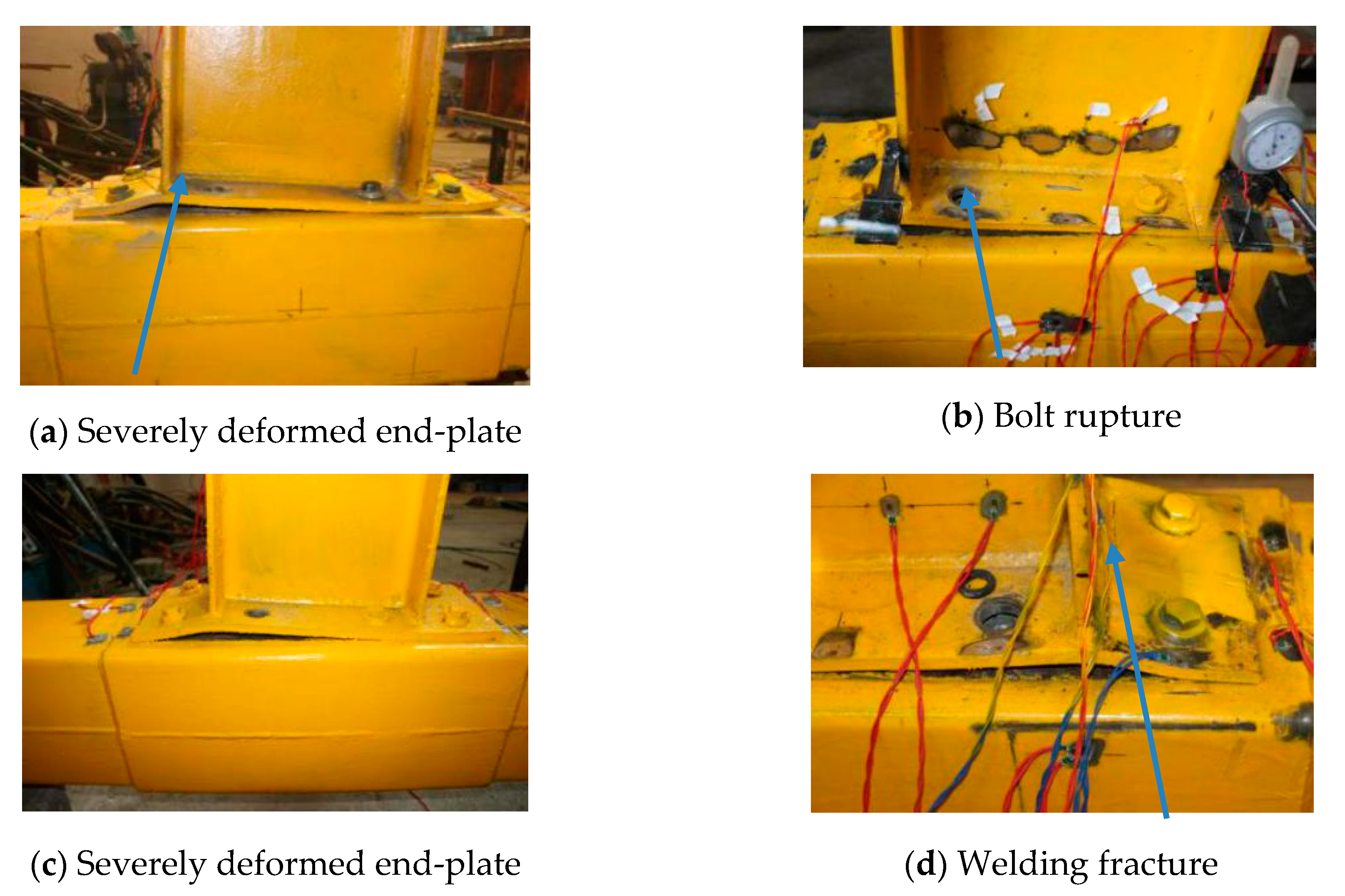

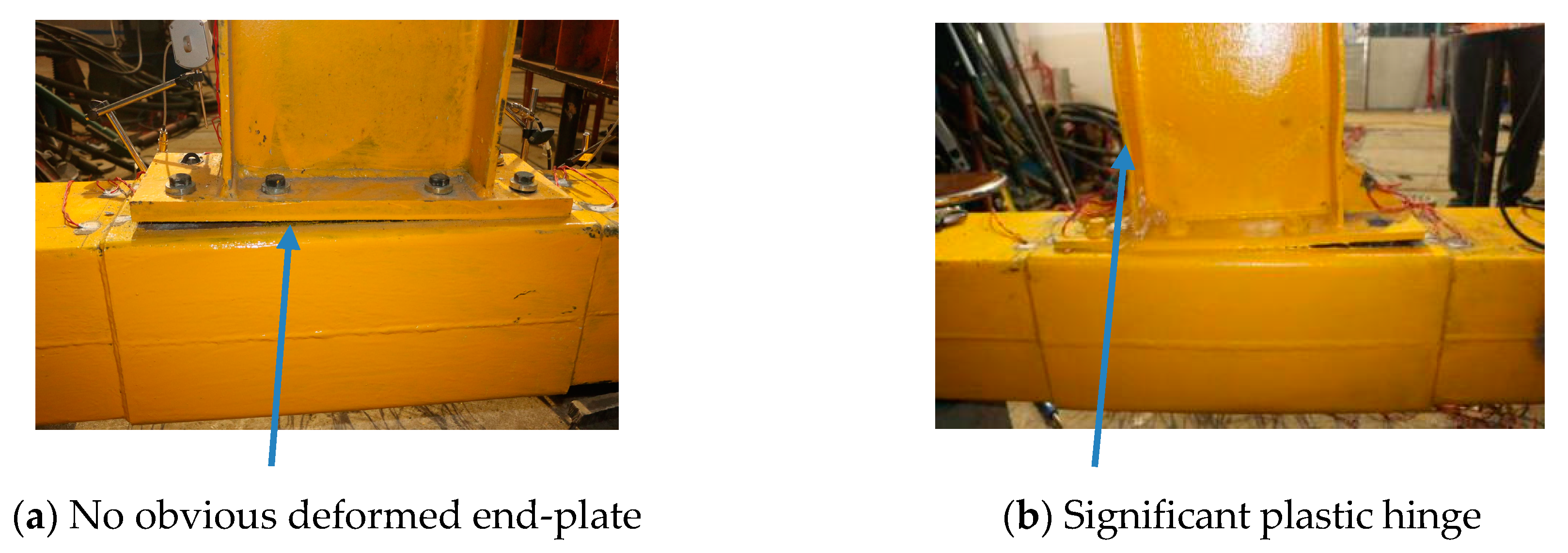

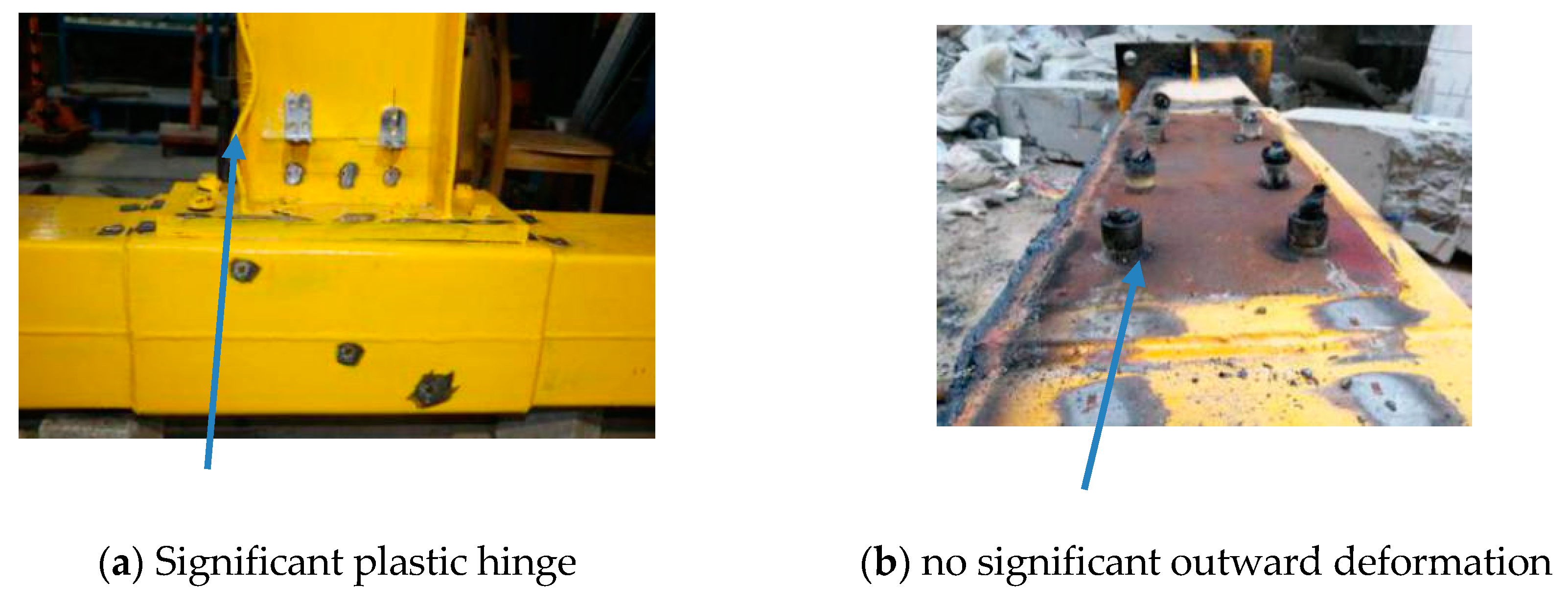

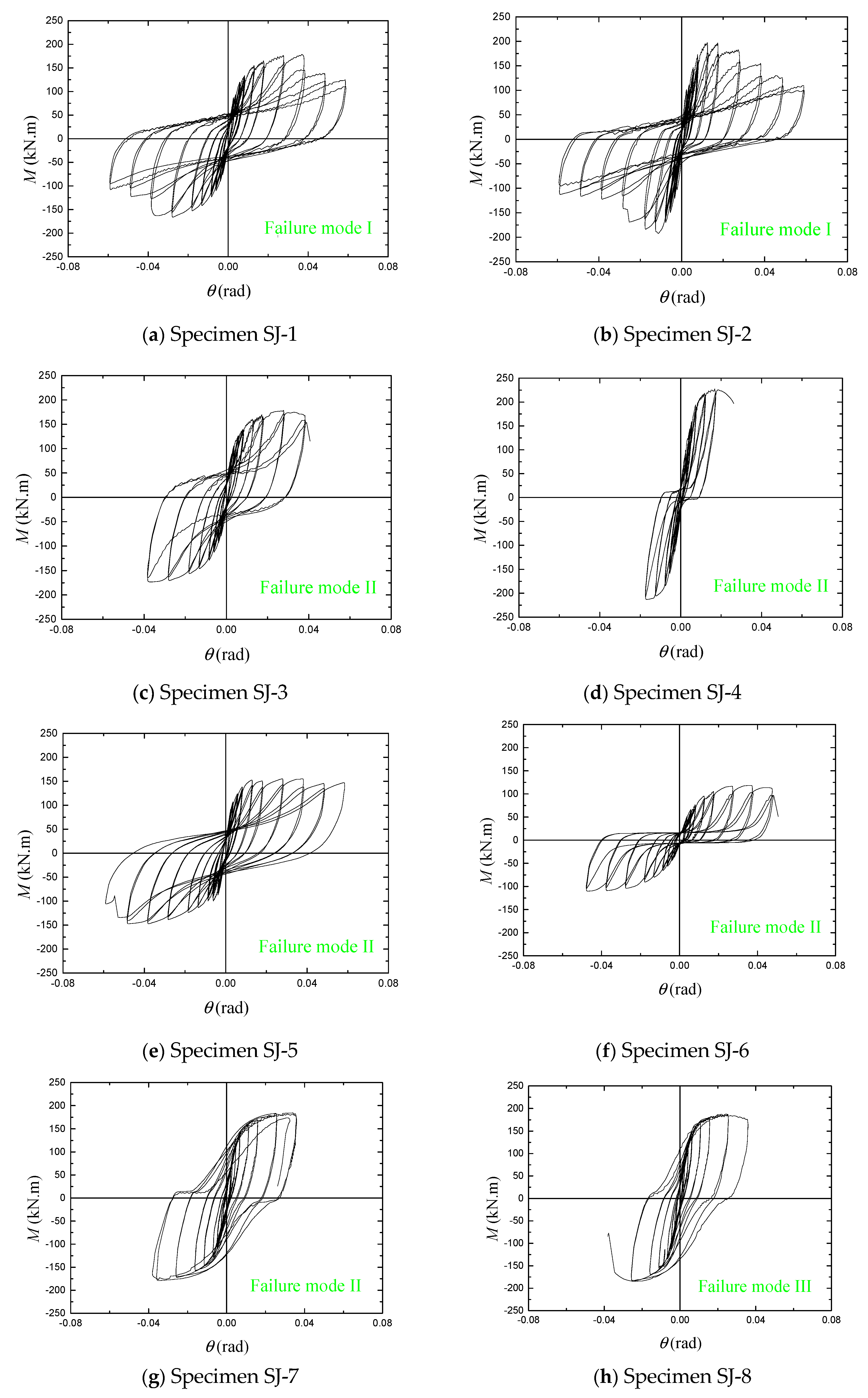
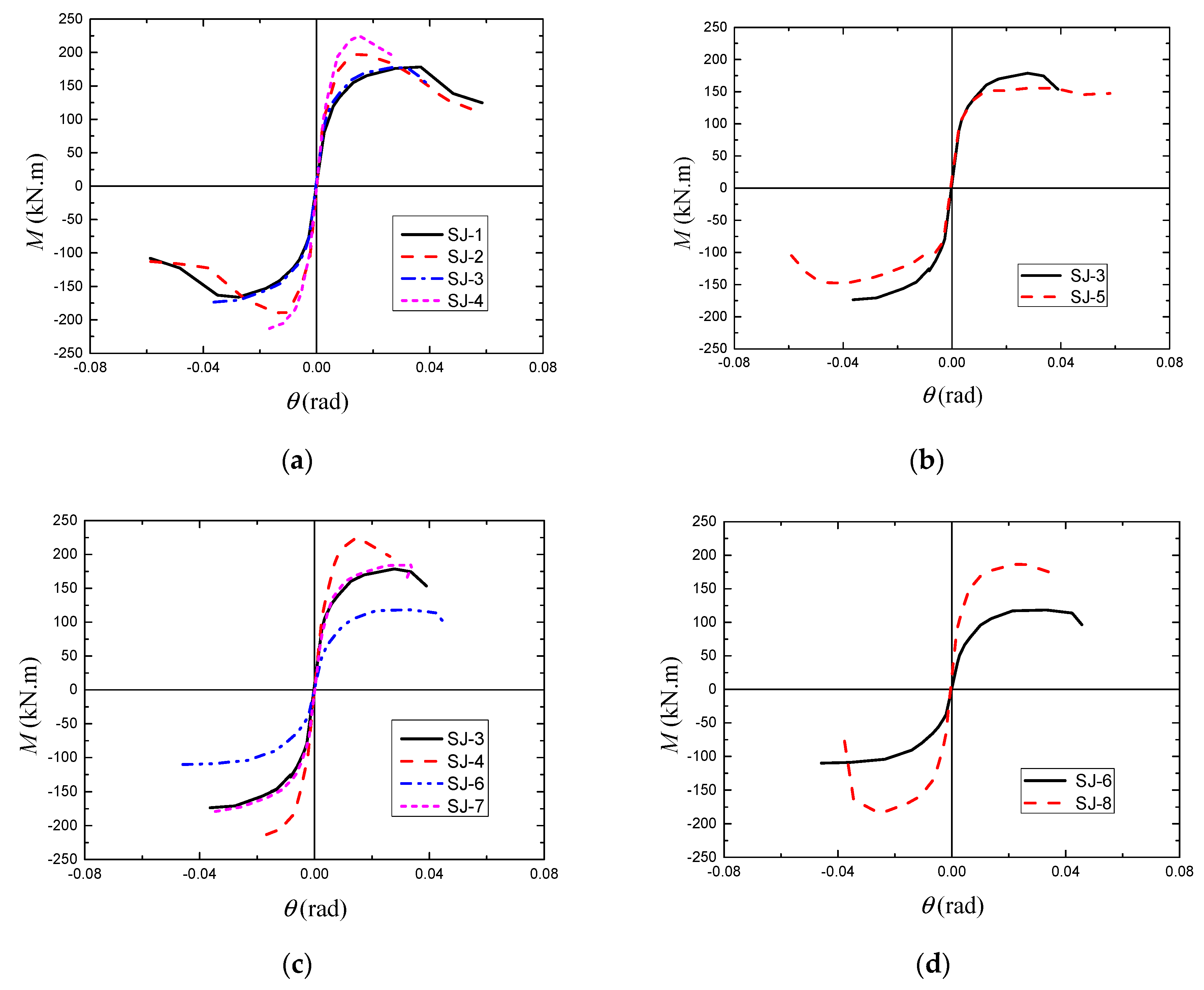

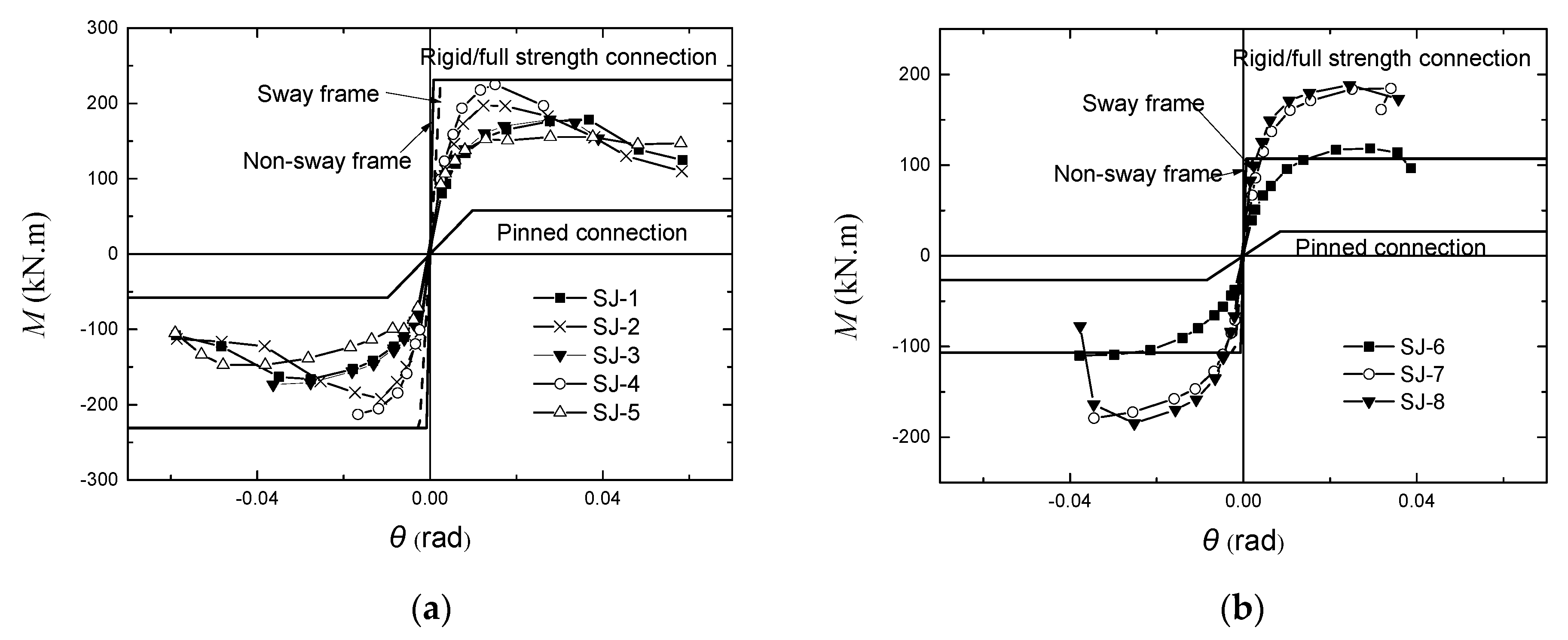


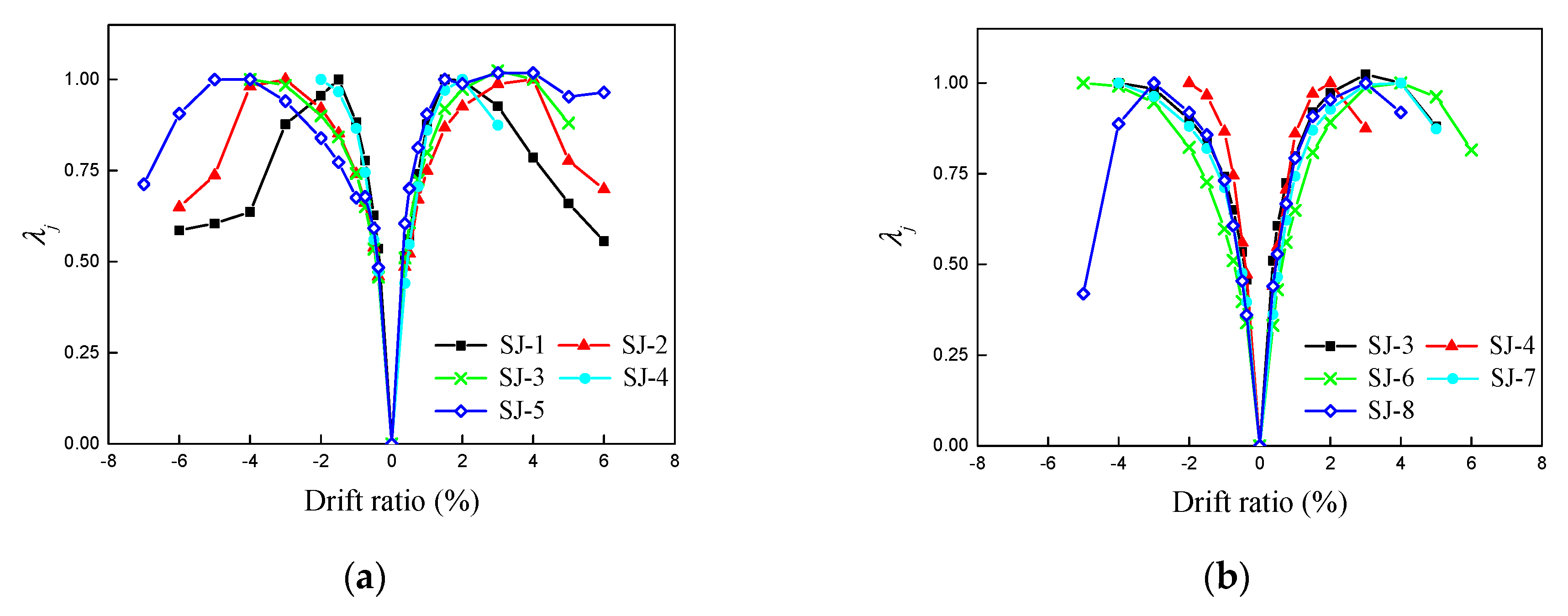
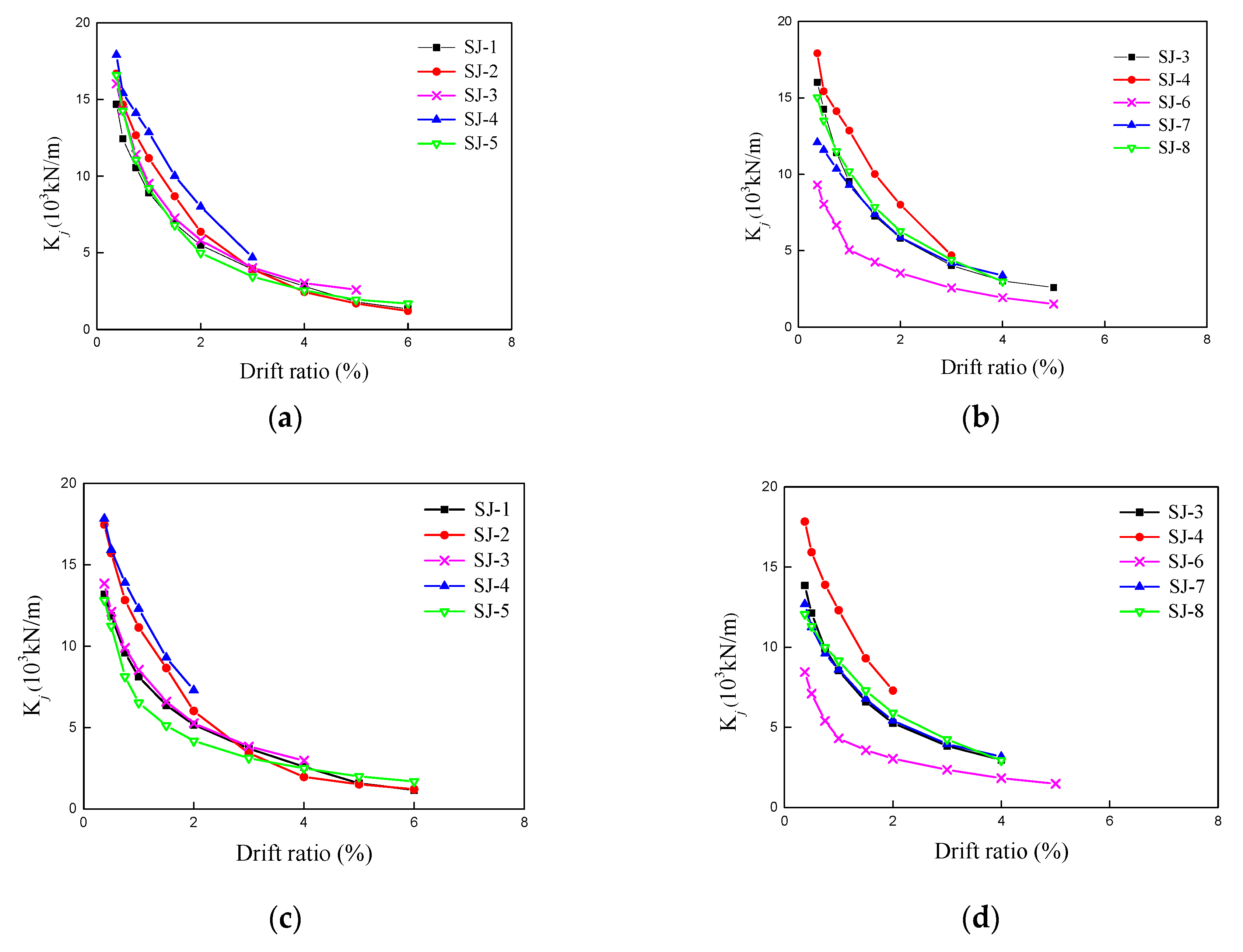

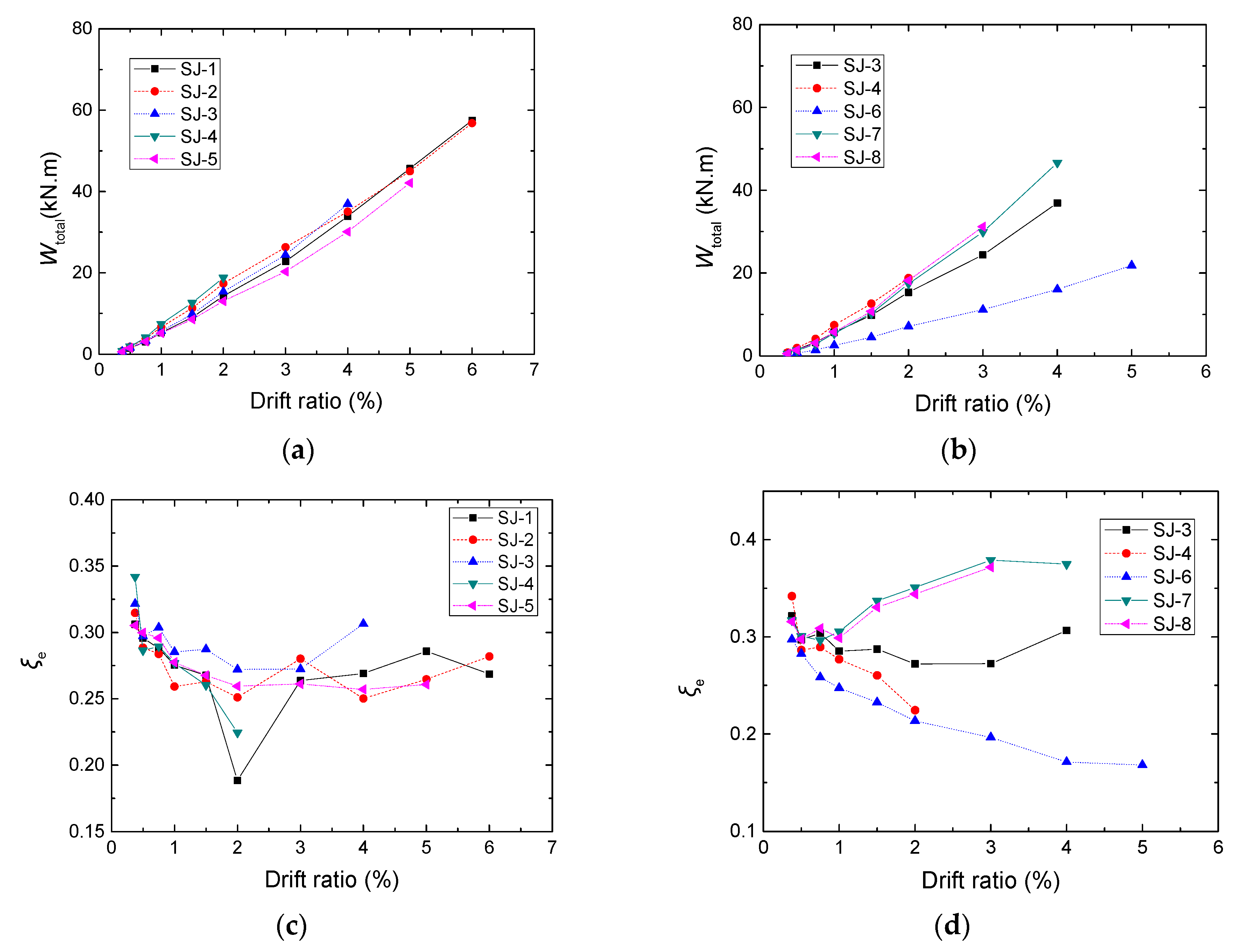
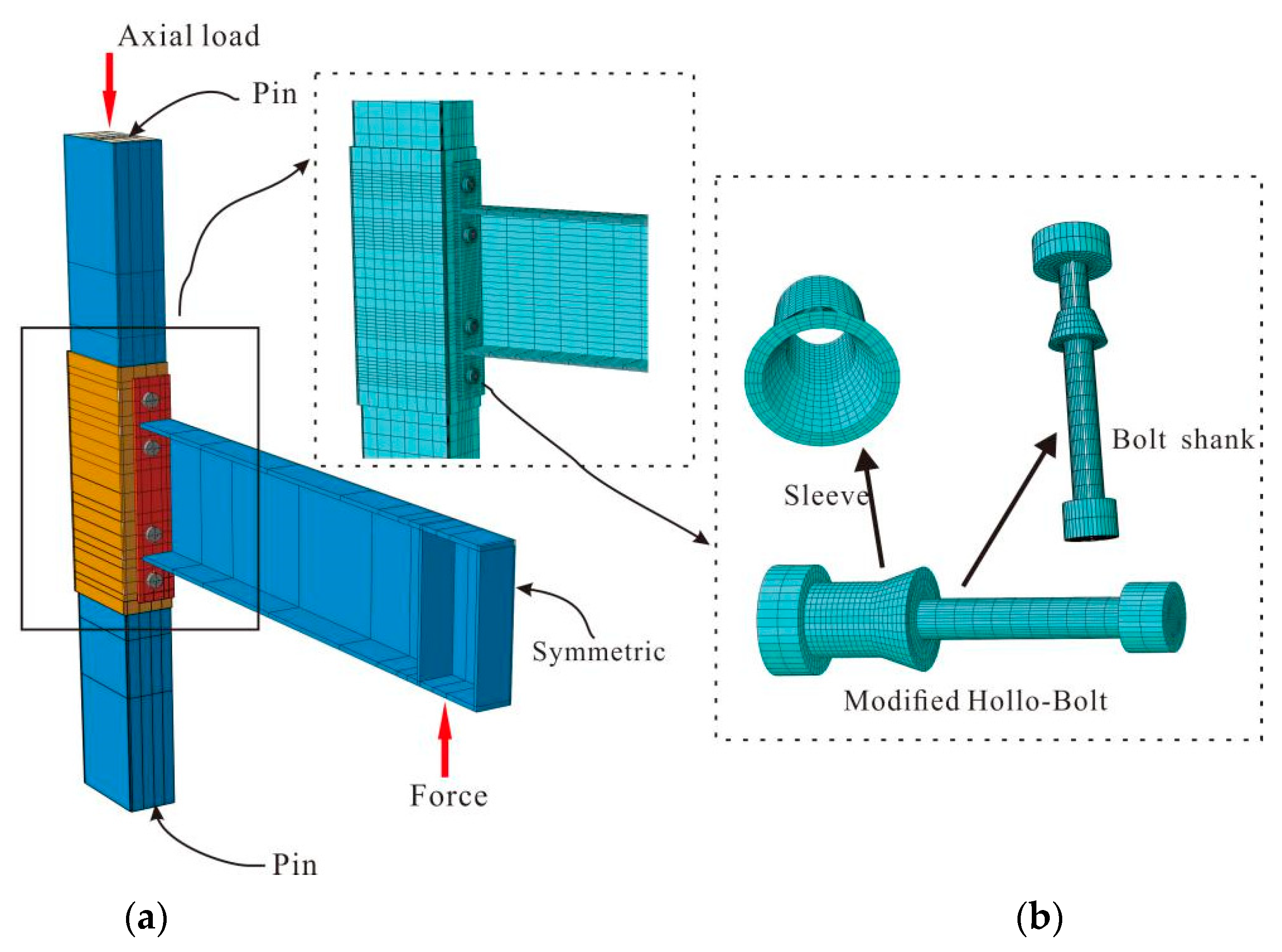
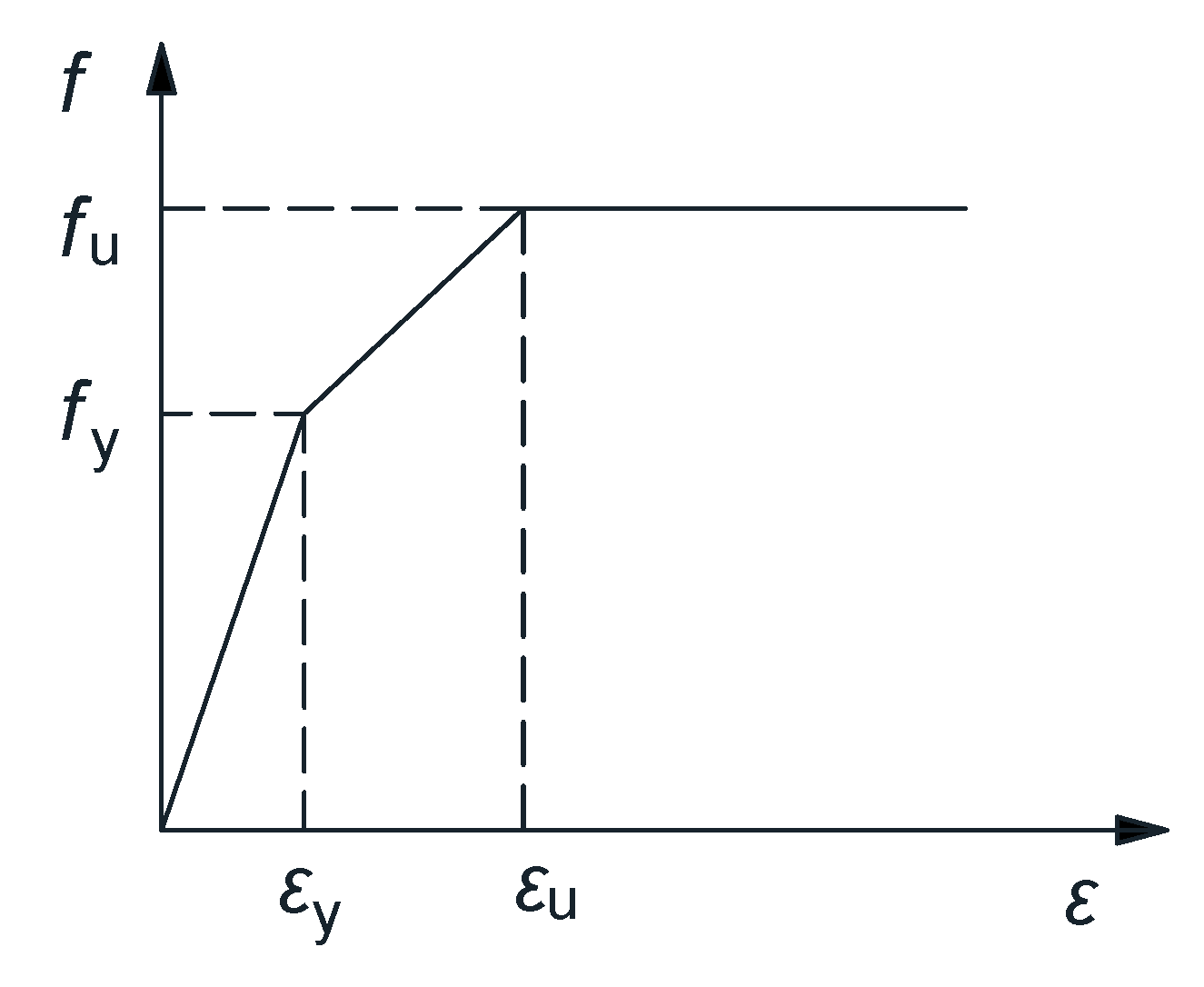
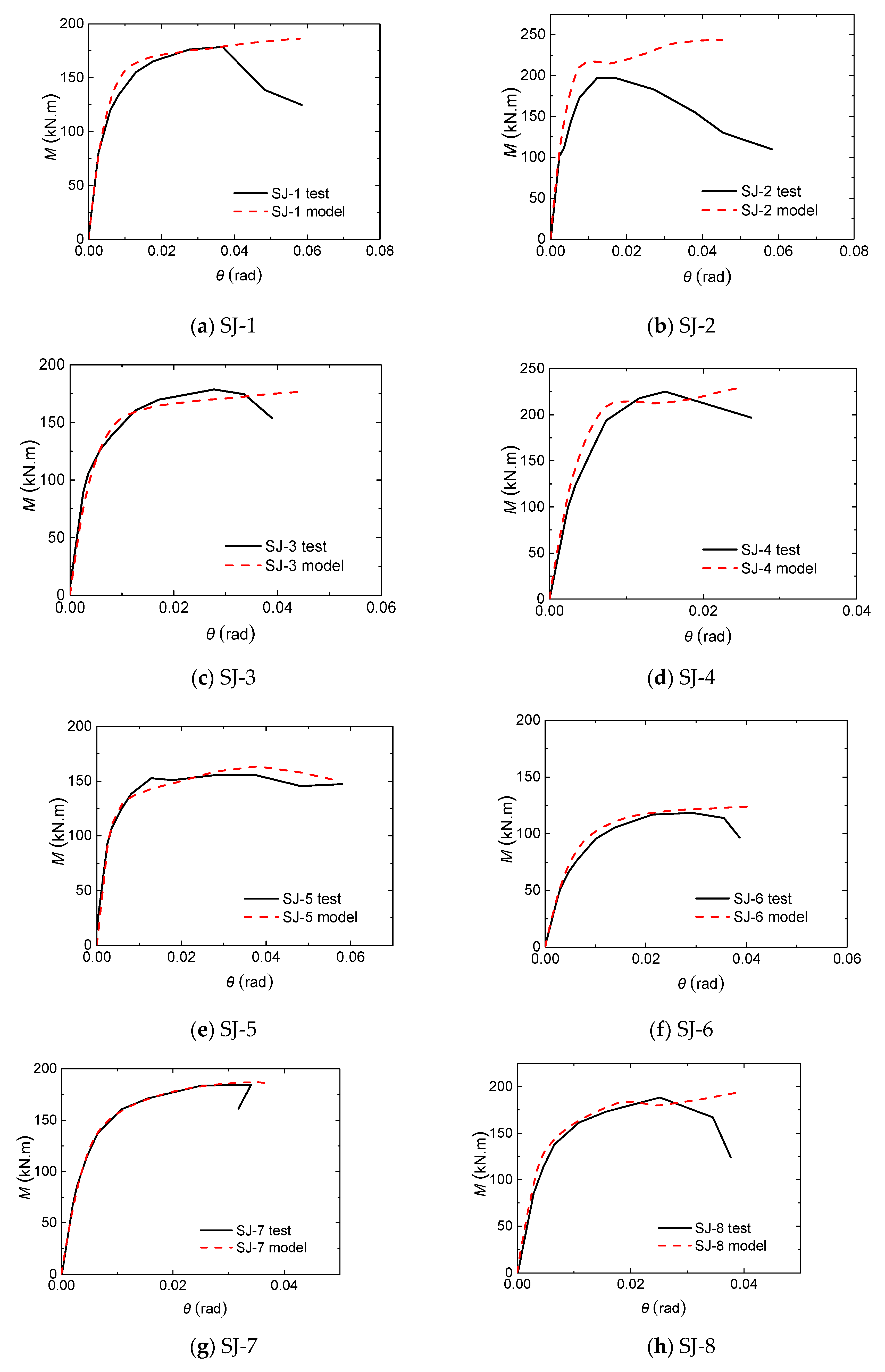
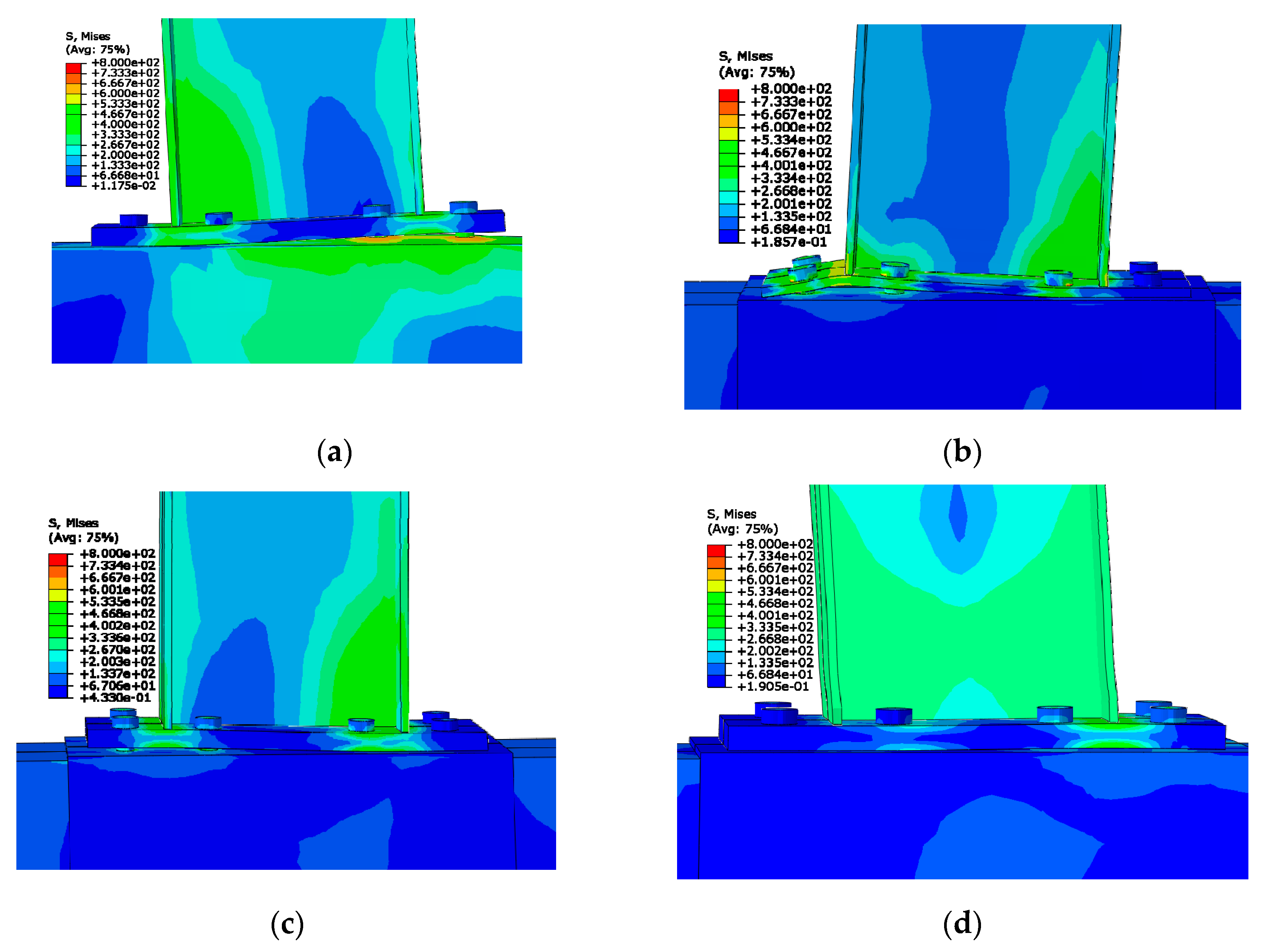

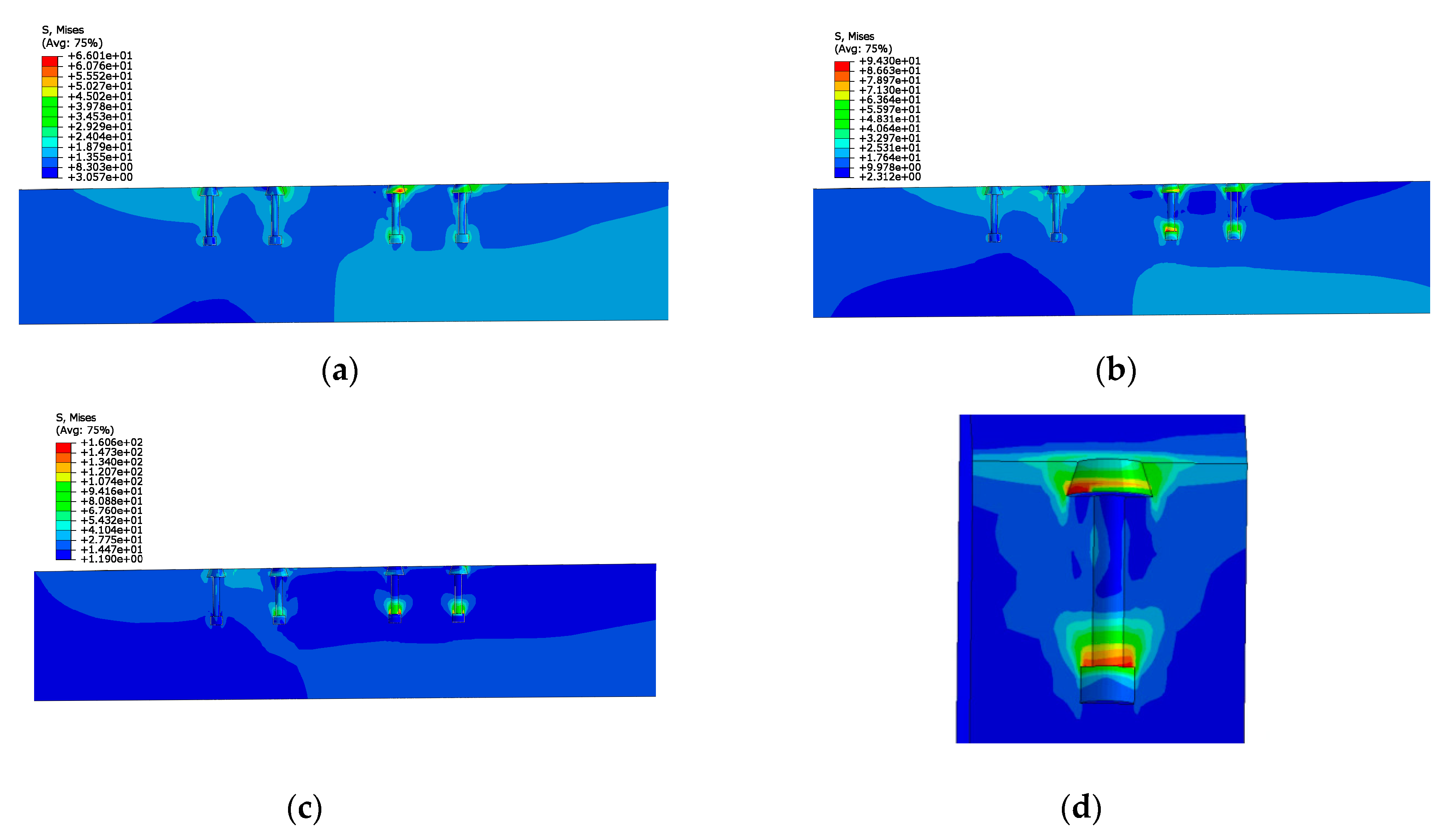
| Specimen Number | Column Section (mm) | Column Length (mm) | Beam Section (mm) | End-Plate Thickness (mm) | Local Reinforcement | Anchorage Method | Stiffener |
|---|---|---|---|---|---|---|---|
| SJ-1 | 250 × 5 | 1736 | HN350 × 175 × 7 × 11 | 12 | None | Nut | None |
| SJ-2 | 250 × 5 | 1736 | HN350 × 175 × 7 × 11 | 24 | None | Nut | None |
| SJ-3 | 250 × 5 | 1736 | HN350 × 175 × 7 × 11 | 12 | With | Nut | None |
| SJ-4 | 250 × 5 | 1736 | HN350 × 175 × 7 × 11 | 24 | With | Nut | None |
| SJ-5 | 250 × 5 | 1736 | HN350 × 175 × 7 × 11 | 12 | With | None | None |
| SJ-6 | 250 × 5 | 1736 | HN300 × 150 × 6 × 9 | 12 | With | Nut | None |
| SJ-7 | 250 × 5 | 1736 | HN300 × 150 × 6 × 9 | 24 | With | Nut | None |
| SJ-8 | 250 × 5 | 1736 | HN300 × 150 × 6 × 9 | 12 | With | Nut | With |
| Steel Component | Thickness (mm) | Es (GPa) | fy (MPa) | fu (MPa) | δ (%) |
|---|---|---|---|---|---|
| End-plate-2 | 25 | 198.26 | 408.5 | 534.5 | 28.7 |
| End-plate-1 | 12 | 197.29 | 399.2 | 562.8 | 25.7 |
| Steel tube | 5 | 208.75 | 477.1 | 609.2 | 21.3 |
| C-channel | 7 | 192.29 | 395.2 | 567.8 | 27.7 |
| Beam flange-1 | 11 | 202.13 | 412.4 | 591.7 | 18.6 |
| Beam web-1 | 7 | 202.35 | 412.6 | 593.7 | 24.83 |
| Beam flange-2 | 9 | 197.41 | 269.7 | 405.7 | 26.6 |
| Beam web-2 | 6 | 192.05 | 254.1 | 397.0 | 30.0 |
| Component | Failure Mode I (Specimen SJ-1 and SJ-2) | Failure Mode II (Specimen SJ-3 ~SJ-6, SJ-8) | Failure Mode III (Specimen SJ-7) |
|---|---|---|---|
| Anchored blind bolt | Partial pull-out | Bolt rupture | Intact |
| Tube wall | Bulging deformation | Slight bulging at the bolt holes | Slight bulging at the bolt holes |
| Concrete in the panel | Severely damaged | Local concrete crush | Local concrete crush |
| Steel beam | No significant plastic hinge of the steel beam | No significant plastic hinge of the steel beam except SJ-8 | Significant plastic hinge of the steel beam |
| Specimen Number | My (kN∙m) | θy (mrad) | Mmax (kN∙m) | θmax (mrad) | Mf (kN∙m) | θf (mrad) | μθ | Ki (kN∙m/mrad) |
|---|---|---|---|---|---|---|---|---|
| SJ-1 | 136.89 | 8.89 | 178.48 | 36.79 | 151.71 | 44.53 | 5.01 | 29.80 |
| SJ-2 | 166.03 | 7.10 | 197.26 | 12.35 | 167.67 | 33.14 | 4.66 | 41.04 |
| SJ-3 | 136.1 | 7.56 | 178.65 | 27.79 | 153.66 | 38.96 | 5.15 | 35.29 |
| SJ-4 | 194.63 | 7.53 | 225.11 | 15.08 | 196.9 | 26.28 | 3.49 | 42.59 |
| SJ-5 | 124.21 | 8.16 | 155.44 | 27.87 | 147.28 | 58.08 | 7.11 | 37.30 |
| SJ-6 | 92.37 | 9.40 | 118.39 | 34.82 | 100.63 | 46.4 | 4.93 | 21.72 |
| SJ-7 | 146.12 | 8.13 | 184.56 | 34.04 | 184.56 | 34.04 | 4.19 | 33.27 |
| SJ-8 | 145.65 | 5.83 | 188.19 | 24.51 | 172.95 | 35.76 | 6.13 | 32.12 |
| Specimen Number | Ee | ξe | Wtotal (kN∙m) |
|---|---|---|---|
| SJ-1 | 1.69 | 0.27 | 57.50 |
| SJ-2 | 1.77 | 0.28 | 56.82 |
| SJ-3 | 1.93 | 0.31 | 36.93 |
| SJ-4 | 1.41 | 0.22 | 18.81 |
| SJ-5 | 1.64 | 0.26 | 42.10 |
| SJ-6 | 1.06 | 0.17 | 21.83 |
| SJ-7 | 2.35 | 0.37 | 46.63 |
| SJ-8 | 2.33 | 0.37 | 31.19 |
© 2020 by the authors. Licensee MDPI, Basel, Switzerland. This article is an open access article distributed under the terms and conditions of the Creative Commons Attribution (CC BY) license (http://creativecommons.org/licenses/by/4.0/).
Share and Cite
Wang, Y.; Wang, Z.; Pan, J.; Wang, P.; Qin, J.; Chen, S. Cyclic Behavior of Anchored Blind-Bolted Extended End-Plate Joints to CFST Columns. Appl. Sci. 2020, 10, 904. https://doi.org/10.3390/app10030904
Wang Y, Wang Z, Pan J, Wang P, Qin J, Chen S. Cyclic Behavior of Anchored Blind-Bolted Extended End-Plate Joints to CFST Columns. Applied Sciences. 2020; 10(3):904. https://doi.org/10.3390/app10030904
Chicago/Turabian StyleWang, Yihuan, Zhan Wang, Jianrong Pan, Peng Wang, JianGui Qin, and Shizhe Chen. 2020. "Cyclic Behavior of Anchored Blind-Bolted Extended End-Plate Joints to CFST Columns" Applied Sciences 10, no. 3: 904. https://doi.org/10.3390/app10030904
APA StyleWang, Y., Wang, Z., Pan, J., Wang, P., Qin, J., & Chen, S. (2020). Cyclic Behavior of Anchored Blind-Bolted Extended End-Plate Joints to CFST Columns. Applied Sciences, 10(3), 904. https://doi.org/10.3390/app10030904





